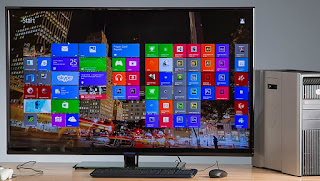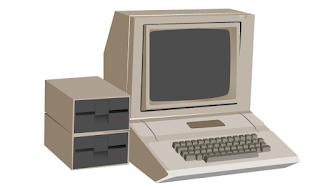Turn a Desktop PC into a Home Media Centre
There
are many ways to hook up a desktop PC to your TV, but here I'm going
to go through the simplest way and how to get going.
Firstly,
if you have a spare tower system, it is preferable to have at least a
Dual Core processor and at least 2gb ddr2 memory, as you will be
streaming video at the very least. If the machine is a single core,
and cannot accommodate a dual core, look into upgrading the
motherboard, low end modern motherboards are very reasonably priced
on ebay.
If
the motherboard is an intel board or has onboard graphics, it is a
good idea to upgrade the graphics with a graphics card. When
installing the card, the graphics don't need to use the on-board
memory, as they are equipped with their own memory. I would recommend
a 1gb card or higher, these can be sourced cheaply on ebay, I
recently purchased a 1gb nvidia card for only £12.
The
PC can be placed underneath the TV sideways or upright next to it.
Try to put it in a position where it can sit dust free and with
plenty of space around it for cooling. You will need to be able to
plug in the PC for power, and also be able to connect to your router
via an Ethernet cable, which will plug straight in to both PC and
Router. You can connect wirelessly via built in wifi, wifi card or
dongle, but you are better off wired into the router for maximum
performance.
Basically
what we now do is connect the same as you would with a standard
monitor. Use a double ended VGA cable, connect to the VGA port in the
back of the TV and also the VGA port in the graphics card, then
connect an audio jack cable to the tv audio port and the PC speaker
jack (the green one). The audio port for the TV may be RCA
connectors, if RCA to jack is needed, they can be found on ebay or
sometimes even your local PoundShop.
Turn
on the TV and the PC, the PC will boot up, and you just need to tune
to the right channel. Usually on the TV remote, there is a button
that says input (or source, or you may have separate buttons for each
channel, or sometimes you have to enter the Menu) and each time you
press the input button, it will scroll through the various inputs in
your TV, from HDMI inputs and SCART inputs to coaxial aerial (tuner),
if you have an older model TV. The channel you need will come up as
VGA, or computer, or RGB, this is the input from the VGA cable and
you will see your desktop on the TV screen. You may need to go into
Windows Control Panel (or equivalent for mac and linux) and change
the resolution settings, but this is the easiest way to hook up. You
can now access Youtube, Twitter, Facebook, Netflix, or anything else
through your TV using your wireless mouse and keyboard instead of a
remote control.
If
your PC and TV use DVI ports as opposed to VGA, simply get yourself a
DVI cable, which will actually give you a better resolution, and if
you have a graphics/video card that is equipped with an HDMI port,
then connect with an HDMI cable, just remember to tune into the
correct HDMI channel on your TV.
This
is the basic setup and I would advise simply using it with your
standard Operating System until you are use to it.
When
you feel comfortable, you can take the next step, which is changing
from a PC to a Media Centre.
Firstly,
there are a number of ways that you can do this, there are software
that you can actually turn the PC into a home media centre, and also
a media server, such as Plex. I would research this before choosing
this option, but it basically means that you install the Plex server
software, leave the machine running, as it is now a server, and you
can watch your media or listen to your music at work, by logging into
your free Plex online account.
For
more information:
How
the Plex Media Server Works - The Basics
Plex
is really for the intermediate user, I would look at the other
programs on offer first, such as XBMC (Kodi), Freevo, or MythTV.
I
personally went for XBMC, which is now KODI, over the other programs.
It is the most popular, and there is a massive pool of help videos on
Youtube and Vevo, and sites dedicated to teaching you how to get it
working the way you want. Also, it can be an ongoing project, due to
developers coming up with new stuff all the time.
There
are two ways to install Kodi, as a full Operating System or as a
program in Windows. I installed as a full OS the first time that I
tried it, and ended up missing the desktop for general use. So I
reinstalled Windows 7 installed KODI as a program in Windows, this I
would recommend to you unless you have no need for the desktop.
To
install as a stand alone OS, the first thing you need to do is
download the required ISO file for installing KODIbuntu, this is an
ISO file, or a complete disk image, which you can burn to a blank DVD
using a program such as BurnAware
free or ISO Burner free.
You
can download the ISO file from http://kodi.tv/download/
Here
you can choose your OS and find a compatible program or download the
ISO
(Kodibuntu:
64bit)
Once
downloaded, burn to a blank DVD. When this DVD is burned, you place
it into the DVD drive of the computer, and boot to the DVD, and
install as prompted. Make sure that you are connected to the
internet, so that any updates available can be downloaded during
installation. If you have any problems with the install, there are
plenty of videos on youtube or try here
If
you want to keep your windows desktop, simply download the windows
version of KODI (http://kodi.tv/download/)
and install as instructed.
Kodi
works on the system of repositories, which can be a little daunting
at first, but as I said, there is a lot of help out there for KODI
users. I have compiled a quick list for you if your interested.
Simply Austin Channel
https://www.youtube.com/channel/UCb4RFFBZEztOW77onViqoDA
Simply Austin Channel
https://www.youtube.com/channel/UCb4RFFBZEztOW77onViqoDA
KODI for Newbies - 3 Easy Steps to Get you started right away
Kodi For Beginners Video 1
Beginners Guide to Getting More add-ons installed to XBMC or KODI
Kodi - Easy Setup, Step-by-Step
kodi tv explained
XBMC/KODI beginners guide - an introduction and tour
Try
this out, try other programs such as MythTV, and just have fun. Set
up an old tower for test purposes, as I did. I installed XBMC to a
harddrive, then swapped the drive for a blank one and install MythTV,
I ended up with about four different harddrives, but I enjoyed
messing around with the different systems.
This
will also work if you have an old laptop with a broken screen. I once
set up this system in my friends kitchen with a laptop, we removed
the complete lid and screen assembly and fixed the base of the laptop
to the wall with an old TV bracket, and it worked fine.
So
have fun and bye for now!












Comments
Post a Comment